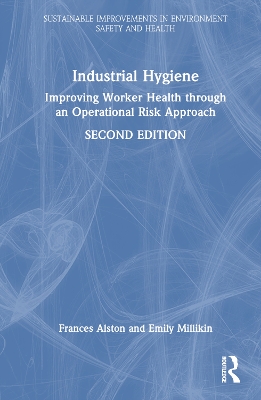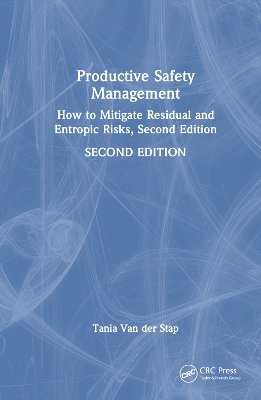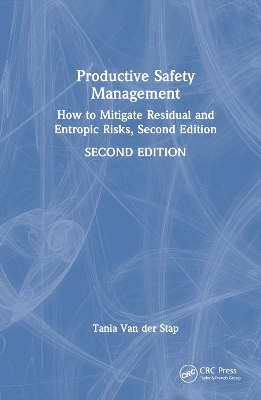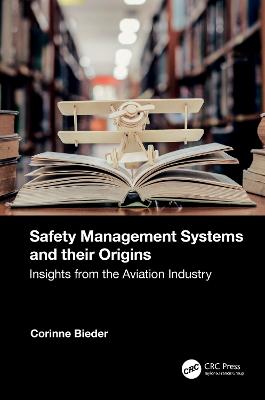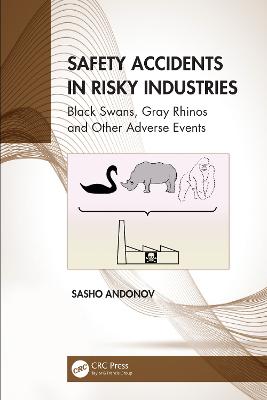Industrial Hygiene
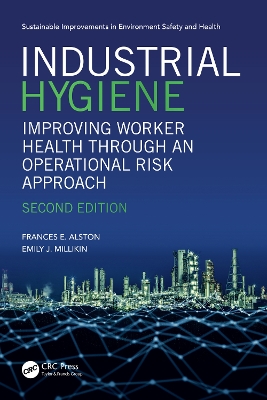 portes grátis
portes grátis
Industrial Hygiene
Improving Worker Health through an Operational Risk Approach, Second Edition
Alston, Frances; Millikin, Emily
Taylor & Francis Ltd
11/2024
192
Mole
9781032597645
Pré-lançamento - envio 15 a 20 dias após a sua edição
Descrição não disponível.
Contents
Preface
About the authors
Acronyms
Chapter 1 Occupational Safety and Health in the Workplace
1.1 Introduction
1.2 Multiple Facets of the Safety and Health Professional
1.3 Industrial Hygiene Program Tenants
1.4 Application and Implementation of Industrial Hygiene Program Elements
1.4.1 Program Management and Administration
1.4.2 Hazard Identification and Control Process
1.4.3 Occupational Health Management
1.4.4 Instrumentation and Calibration
1.4.5 Data Management, Records and Reporting
1.4.6 Training and Qualification
1.4.7 Continuous Improvement
1.5 Industrial Hygiene Key Focus Areas and Risk Reduction
Questions to Ponder for Learning
Chapter 2 Art of Science of Industrial Hygiene
2.1 Introduction
2.2 The Art of Industrial Hygiene
2.2.1 The Art of Hazard Recognition and Control
2.2.2 The Art of an Occupational Exposure Monitoring Strategy
2.2.3 The Art of the Occupational Health Program
2.2.4 The Art of People Management
2.2.4.1 Solicit Feedback from the Workforce
2.2.4.2 Team with the Workforce in Preventing Hazards
2.2.4.3 Provide Positive Feedback
2.2.4.4 Be Respectful and Trusting
2.3 The Science of Industrial Hygiene
2.3.1 The Science of Hazard Recognition and Control
2.3.2 The Science of an Occupational Exposure Monitoring Strategy
2.3.3 The Science of the Occupational Health Program
2.3.4 The Science of People Management
Questions to Ponder for Learning
Chapter 3 Industrial Hygiene Professional
3.1 Introduction
3.2 Role of the Industrial Hygiene Professional
3.3 Leadership and Organizational Structure
3.3.1 Flat Organizational Structure
3.3.2 Hierarchical Organizational Structure
3.4 Communication for Results
3.4.1 Technical and Non-Technical Workers and Colleagues
3.4.2 Risk/Exposure Assessment Data and Results
3.4.3 Relationship with the Workforce
3.4.4 Engagement on Work Planning Teams
3.5 Corporate Programmatic Support Role
3.6 Industrial Hygienist as an Expert Witness
3.7 Continuing Education and Professional Development
3.7.1 College and University Curricula
3.7.2 Retention of the Industrial Hygiene Professional
3.7.3 Industrial Hygiene Certification
3.7.4 Continuing Education
3.7.5 Job Rotation
3.7.6 Industrial Hygiene as a Generalist
3.8 Legal and Ethical Aspects of Industrial Hygiene
3.8.1 Professionalism
3.8.2 Accountability
3.8.3 Humility
3.8.4 Reliability
3.8.5 Trustworthiness
3.9 Management of Industrial Hygiene Projects
3.10 Emergency Response and Monitoring
Questions to Ponder for Learning
Chapter 4 Strategies for Exposure Monitoring and Instrumentation
4.1 Introduction
4.2 Regulatory Aspects of Industrial Hygiene
4.3 Quantitative and Qualitative Exposure and Risk Assessment
4.3.1 Quantitative Exposure and Risk Assessment
4.3.2 Qualitative Exposure and Risk Assessment
4.4 Process Flow of Exposure Assessment
4.4.1 Defining the Scope of Work
4.4.2 Developing a Monitoring Plan
4.4.3 Implementing the Characterization and Monitoring Plan
4.4.4 Similar Exposure Groups
4.4.5 Occupational Exposure Control Banding
4.4.6 Evaluating Data and Characterizing Exposures
4.4.6.1 Application of non-threshold versus linear threshold models
4.4.6.2 Occupational Exposure and Administrative Control Limits
4.4.7 Develop Controls
4.4.8 Document Results
4.4.8.1 Peer Review and Validation
4.4.9 Communicate Data Results
4.4.10 Develop a Reevaluation Plan
4.5 Occupational Safety and Health Characterization and Monitoring Equipment
4.5.1 Diffusion Detector Tubes
4.5.2 Vapor Monitor Badges
4.5.3 Personal Air Sampling Pumps
4.5.4 Handheld Electronic Monitors
4.5.5 Fixed Air Monitors
4.6 Case Studies to Facilitate Thoughtful Learning
4.6.1 "The Presence of Intermittent Odor"
4.6.2 "The Presence of Intermittent Odor" Lessons Learned
4.6.3 "I Have Been Sick for 6 Months"
4.6.4 "I Have Been Sick for 6 Months" Lessons Learned
Questions to Ponder for Learning
Chapter 5 Risk-Based Industrial Hygiene
5.1 Introduction
5.2 Importance of Risk Assessment and a Risk-Based Approach to Hazard Management
5.3 Identifying and Controlling Workplace Risks
5.4 Addressing Industrial Hygiene Risks in the Workplace
5.4.1 Industrial Hygiene Risk Assessment
5.5 Risk Ranking
5.6 Integration of a Rick-Based Consensus Standard Into Industrial Hygiene
5.6.1 Industrial Hygiene Program Management and Administration
5.6.2 Hazard Identification and Control Process
5.6.3 Occupational Health Management
5.6.4 Instrumentation and Calibration
5.6.5 Data Management, Records, and Reporting
5.6.6 Training and Qualification
5.6.7 Continuous Improvement
5.7 Risk Communications
5.8 Risk Acceptance
Questions to Ponder for Learning
Chapter 6 Recognizing, Evaluating, and Controlling Workplace Hazards
6.1 Introduction
6.2 Historical Chemical and Industrial Hazards
6.3 Chemical, Physical, Biological and Industrial Hazards of the Past Decade
6.4 Workplace Hazard Inventories
6.4.1 Task Hazard Inventory
6.4.2 Facility Hazard Inventory
6.5 Injury and Illness Logs and Inspection Trending
6.6 Chemical Inventories: Usage, Storage, and Disposal Records
6.7 Biological and Radiological Hazards Considerations
6.8 Regulatory Inspections and Violations
6.9 Hazard Control and Work Execution
6.9.1 Hazard Elimination
6.9.2 Product Substitution
6.9.3 Engineering Controls
6.9.4 Work Practices and Administrative Controls
6.9.5 Personal Protective Equipment
6.10 Integration of Hazard Recognition and Controls
6.10.1 Planning Work
6.10.2 Authorizing Work
6.10.3 Work Execution
6.10.4 Project Closeout
6.11 Management by Walk-Around
6.11.1 Preparation
6.11.2 Communication
6.11.3 Persistence to Connect
6.12 Safety Through Design Designing Hazards Out of the Process
6.13 Employee Engagement
Questions to Ponder for Learning
Chapter 7 Medical Monitoring and Surveillance of the Worker
7.1 Introduction
7.2 Medical Monitoring and Surveillance Program
7.3 Establishment of Company Policies, Protocols, and Procedures
7.4 Scheduling and Tracking of Physicals
7.5 Interfacing with Medical Professionals
7.6 Notification of Test Results
7.7 Analysis of Occupational Health Dat
7.8 Medical Monitoring Records and Reporting
7.9 Case Study 1: Chromium IV Exposure
7.10 Case Study 2: Beryllium Exposure
Questions to Ponder for Learning
Chapter 8 Workforce Training on Hazard Recognition and Control
8.1 Introduction
8.2 Why Provide Workplace Training?
8.3 Developing an Effective Training Strategy
8.4 Hazard Recognition, Evaluation, and Control Training
8.4.1 Hazard Anticipation
8.4.2 Hazard Recognition and Identification
8.4.3 Evaluate Hazards
8.4.4 Controlling Hazards
8.5 Trainer Knowledge and Qualification
8.6 Training Effectiveness Evaluation
8.7 Other Training Methods and Tools
8.7.1 Process or Tool Mock-Up
8.7.2 Peer-to-Peer Training
8.7.3 Training on the Job Site
8.7.4 Hazard Identification Checklist
8.7.5 The Use of Case Studies to Enforce Learning
8.7.6 Micro Learning
Questions to Ponder for Learning
Chapter 9 Industrial Hygiene and Emergency Response
9.1 Introduction
9.1.1 Hurricane Katrina - United States
9.1.2 La Porte, Texas Chemical Plant - United States
9.1.3 September 11, 2001 - United States
9.1.4 Collapse of the Rana Plaza - Bangladesh
9.1.5 Glasgow Explosion - Scotland
9.2 Approaches to Emergency Response
9.3 Initiating Event
9.4 Event Notification
9.5 Risk Prioritization
9.6 Event Response
9.6.1 Resources and Equipment
9.6.2 Logistical Support
9.6.3 Event Response Communication
9.6.4 Event or Site Transition
9.7 Lessons Learned From 9/11
9.7.1 Event Notification
9.7.2 Event Response
9.7.3 Site Transition
Questions to Ponder for Learning
Chapter 10 Evaluating the Industrial Hygiene Program
10.1 Introduction
10.2 Identifying the Program and Process to Assess
10.3 Identifying Key Attributes to Assess
10.4 Developing the Assessment Plan and Lines of Inquiry
10.5 Performing the Assessment
10.6 Data Analysis
10.6.1 Data Organization
10.6.2 Analysis Method
10.6.3 Risk Management of Identified Hazards
10.6.4 Relationship of Data to Existing Programs and Processes
10.6.5 Data Storage and Management
10.7 Document Assessment Results
Questions to Ponder for Learning
Chapter 11 Continuous Improvement
11.1 Introduction
11.2 Continuous Improvement Process
11.3 Establishing the Performance Baseline
11.4 Identify Areas for Improvement
11.5 Industrial Hygiene Continuous Improvement Plan
11.5.1 Goals and Objectives
11.5.2 Corrective Actions and Improvement Initiatives
11.6 Performance Monitoring and Metrics
11.7 Case Study: Tungsten Tools
Questions to Ponder for Learning
Index
Preface
About the authors
Acronyms
Chapter 1 Occupational Safety and Health in the Workplace
1.1 Introduction
1.2 Multiple Facets of the Safety and Health Professional
1.3 Industrial Hygiene Program Tenants
1.4 Application and Implementation of Industrial Hygiene Program Elements
1.4.1 Program Management and Administration
1.4.2 Hazard Identification and Control Process
1.4.3 Occupational Health Management
1.4.4 Instrumentation and Calibration
1.4.5 Data Management, Records and Reporting
1.4.6 Training and Qualification
1.4.7 Continuous Improvement
1.5 Industrial Hygiene Key Focus Areas and Risk Reduction
Questions to Ponder for Learning
Chapter 2 Art of Science of Industrial Hygiene
2.1 Introduction
2.2 The Art of Industrial Hygiene
2.2.1 The Art of Hazard Recognition and Control
2.2.2 The Art of an Occupational Exposure Monitoring Strategy
2.2.3 The Art of the Occupational Health Program
2.2.4 The Art of People Management
2.2.4.1 Solicit Feedback from the Workforce
2.2.4.2 Team with the Workforce in Preventing Hazards
2.2.4.3 Provide Positive Feedback
2.2.4.4 Be Respectful and Trusting
2.3 The Science of Industrial Hygiene
2.3.1 The Science of Hazard Recognition and Control
2.3.2 The Science of an Occupational Exposure Monitoring Strategy
2.3.3 The Science of the Occupational Health Program
2.3.4 The Science of People Management
Questions to Ponder for Learning
Chapter 3 Industrial Hygiene Professional
3.1 Introduction
3.2 Role of the Industrial Hygiene Professional
3.3 Leadership and Organizational Structure
3.3.1 Flat Organizational Structure
3.3.2 Hierarchical Organizational Structure
3.4 Communication for Results
3.4.1 Technical and Non-Technical Workers and Colleagues
3.4.2 Risk/Exposure Assessment Data and Results
3.4.3 Relationship with the Workforce
3.4.4 Engagement on Work Planning Teams
3.5 Corporate Programmatic Support Role
3.6 Industrial Hygienist as an Expert Witness
3.7 Continuing Education and Professional Development
3.7.1 College and University Curricula
3.7.2 Retention of the Industrial Hygiene Professional
3.7.3 Industrial Hygiene Certification
3.7.4 Continuing Education
3.7.5 Job Rotation
3.7.6 Industrial Hygiene as a Generalist
3.8 Legal and Ethical Aspects of Industrial Hygiene
3.8.1 Professionalism
3.8.2 Accountability
3.8.3 Humility
3.8.4 Reliability
3.8.5 Trustworthiness
3.9 Management of Industrial Hygiene Projects
3.10 Emergency Response and Monitoring
Questions to Ponder for Learning
Chapter 4 Strategies for Exposure Monitoring and Instrumentation
4.1 Introduction
4.2 Regulatory Aspects of Industrial Hygiene
4.3 Quantitative and Qualitative Exposure and Risk Assessment
4.3.1 Quantitative Exposure and Risk Assessment
4.3.2 Qualitative Exposure and Risk Assessment
4.4 Process Flow of Exposure Assessment
4.4.1 Defining the Scope of Work
4.4.2 Developing a Monitoring Plan
4.4.3 Implementing the Characterization and Monitoring Plan
4.4.4 Similar Exposure Groups
4.4.5 Occupational Exposure Control Banding
4.4.6 Evaluating Data and Characterizing Exposures
4.4.6.1 Application of non-threshold versus linear threshold models
4.4.6.2 Occupational Exposure and Administrative Control Limits
4.4.7 Develop Controls
4.4.8 Document Results
4.4.8.1 Peer Review and Validation
4.4.9 Communicate Data Results
4.4.10 Develop a Reevaluation Plan
4.5 Occupational Safety and Health Characterization and Monitoring Equipment
4.5.1 Diffusion Detector Tubes
4.5.2 Vapor Monitor Badges
4.5.3 Personal Air Sampling Pumps
4.5.4 Handheld Electronic Monitors
4.5.5 Fixed Air Monitors
4.6 Case Studies to Facilitate Thoughtful Learning
4.6.1 "The Presence of Intermittent Odor"
4.6.2 "The Presence of Intermittent Odor" Lessons Learned
4.6.3 "I Have Been Sick for 6 Months"
4.6.4 "I Have Been Sick for 6 Months" Lessons Learned
Questions to Ponder for Learning
Chapter 5 Risk-Based Industrial Hygiene
5.1 Introduction
5.2 Importance of Risk Assessment and a Risk-Based Approach to Hazard Management
5.3 Identifying and Controlling Workplace Risks
5.4 Addressing Industrial Hygiene Risks in the Workplace
5.4.1 Industrial Hygiene Risk Assessment
5.5 Risk Ranking
5.6 Integration of a Rick-Based Consensus Standard Into Industrial Hygiene
5.6.1 Industrial Hygiene Program Management and Administration
5.6.2 Hazard Identification and Control Process
5.6.3 Occupational Health Management
5.6.4 Instrumentation and Calibration
5.6.5 Data Management, Records, and Reporting
5.6.6 Training and Qualification
5.6.7 Continuous Improvement
5.7 Risk Communications
5.8 Risk Acceptance
Questions to Ponder for Learning
Chapter 6 Recognizing, Evaluating, and Controlling Workplace Hazards
6.1 Introduction
6.2 Historical Chemical and Industrial Hazards
6.3 Chemical, Physical, Biological and Industrial Hazards of the Past Decade
6.4 Workplace Hazard Inventories
6.4.1 Task Hazard Inventory
6.4.2 Facility Hazard Inventory
6.5 Injury and Illness Logs and Inspection Trending
6.6 Chemical Inventories: Usage, Storage, and Disposal Records
6.7 Biological and Radiological Hazards Considerations
6.8 Regulatory Inspections and Violations
6.9 Hazard Control and Work Execution
6.9.1 Hazard Elimination
6.9.2 Product Substitution
6.9.3 Engineering Controls
6.9.4 Work Practices and Administrative Controls
6.9.5 Personal Protective Equipment
6.10 Integration of Hazard Recognition and Controls
6.10.1 Planning Work
6.10.2 Authorizing Work
6.10.3 Work Execution
6.10.4 Project Closeout
6.11 Management by Walk-Around
6.11.1 Preparation
6.11.2 Communication
6.11.3 Persistence to Connect
6.12 Safety Through Design Designing Hazards Out of the Process
6.13 Employee Engagement
Questions to Ponder for Learning
Chapter 7 Medical Monitoring and Surveillance of the Worker
7.1 Introduction
7.2 Medical Monitoring and Surveillance Program
7.3 Establishment of Company Policies, Protocols, and Procedures
7.4 Scheduling and Tracking of Physicals
7.5 Interfacing with Medical Professionals
7.6 Notification of Test Results
7.7 Analysis of Occupational Health Dat
7.8 Medical Monitoring Records and Reporting
7.9 Case Study 1: Chromium IV Exposure
7.10 Case Study 2: Beryllium Exposure
Questions to Ponder for Learning
Chapter 8 Workforce Training on Hazard Recognition and Control
8.1 Introduction
8.2 Why Provide Workplace Training?
8.3 Developing an Effective Training Strategy
8.4 Hazard Recognition, Evaluation, and Control Training
8.4.1 Hazard Anticipation
8.4.2 Hazard Recognition and Identification
8.4.3 Evaluate Hazards
8.4.4 Controlling Hazards
8.5 Trainer Knowledge and Qualification
8.6 Training Effectiveness Evaluation
8.7 Other Training Methods and Tools
8.7.1 Process or Tool Mock-Up
8.7.2 Peer-to-Peer Training
8.7.3 Training on the Job Site
8.7.4 Hazard Identification Checklist
8.7.5 The Use of Case Studies to Enforce Learning
8.7.6 Micro Learning
Questions to Ponder for Learning
Chapter 9 Industrial Hygiene and Emergency Response
9.1 Introduction
9.1.1 Hurricane Katrina - United States
9.1.2 La Porte, Texas Chemical Plant - United States
9.1.3 September 11, 2001 - United States
9.1.4 Collapse of the Rana Plaza - Bangladesh
9.1.5 Glasgow Explosion - Scotland
9.2 Approaches to Emergency Response
9.3 Initiating Event
9.4 Event Notification
9.5 Risk Prioritization
9.6 Event Response
9.6.1 Resources and Equipment
9.6.2 Logistical Support
9.6.3 Event Response Communication
9.6.4 Event or Site Transition
9.7 Lessons Learned From 9/11
9.7.1 Event Notification
9.7.2 Event Response
9.7.3 Site Transition
Questions to Ponder for Learning
Chapter 10 Evaluating the Industrial Hygiene Program
10.1 Introduction
10.2 Identifying the Program and Process to Assess
10.3 Identifying Key Attributes to Assess
10.4 Developing the Assessment Plan and Lines of Inquiry
10.5 Performing the Assessment
10.6 Data Analysis
10.6.1 Data Organization
10.6.2 Analysis Method
10.6.3 Risk Management of Identified Hazards
10.6.4 Relationship of Data to Existing Programs and Processes
10.6.5 Data Storage and Management
10.7 Document Assessment Results
Questions to Ponder for Learning
Chapter 11 Continuous Improvement
11.1 Introduction
11.2 Continuous Improvement Process
11.3 Establishing the Performance Baseline
11.4 Identify Areas for Improvement
11.5 Industrial Hygiene Continuous Improvement Plan
11.5.1 Goals and Objectives
11.5.2 Corrective Actions and Improvement Initiatives
11.6 Performance Monitoring and Metrics
11.7 Case Study: Tungsten Tools
Questions to Ponder for Learning
Index
Este título pertence ao(s) assunto(s) indicados(s). Para ver outros títulos clique no assunto desejado.
Toxicity and Dose Response;Hazard Identification and Control;laws and Regulations;Risk Management;Exposure Monitoring;Continuous Improvement;Emily J. Millikin;Willie Piispanen
Contents
Preface
About the authors
Acronyms
Chapter 1 Occupational Safety and Health in the Workplace
1.1 Introduction
1.2 Multiple Facets of the Safety and Health Professional
1.3 Industrial Hygiene Program Tenants
1.4 Application and Implementation of Industrial Hygiene Program Elements
1.4.1 Program Management and Administration
1.4.2 Hazard Identification and Control Process
1.4.3 Occupational Health Management
1.4.4 Instrumentation and Calibration
1.4.5 Data Management, Records and Reporting
1.4.6 Training and Qualification
1.4.7 Continuous Improvement
1.5 Industrial Hygiene Key Focus Areas and Risk Reduction
Questions to Ponder for Learning
Chapter 2 Art of Science of Industrial Hygiene
2.1 Introduction
2.2 The Art of Industrial Hygiene
2.2.1 The Art of Hazard Recognition and Control
2.2.2 The Art of an Occupational Exposure Monitoring Strategy
2.2.3 The Art of the Occupational Health Program
2.2.4 The Art of People Management
2.2.4.1 Solicit Feedback from the Workforce
2.2.4.2 Team with the Workforce in Preventing Hazards
2.2.4.3 Provide Positive Feedback
2.2.4.4 Be Respectful and Trusting
2.3 The Science of Industrial Hygiene
2.3.1 The Science of Hazard Recognition and Control
2.3.2 The Science of an Occupational Exposure Monitoring Strategy
2.3.3 The Science of the Occupational Health Program
2.3.4 The Science of People Management
Questions to Ponder for Learning
Chapter 3 Industrial Hygiene Professional
3.1 Introduction
3.2 Role of the Industrial Hygiene Professional
3.3 Leadership and Organizational Structure
3.3.1 Flat Organizational Structure
3.3.2 Hierarchical Organizational Structure
3.4 Communication for Results
3.4.1 Technical and Non-Technical Workers and Colleagues
3.4.2 Risk/Exposure Assessment Data and Results
3.4.3 Relationship with the Workforce
3.4.4 Engagement on Work Planning Teams
3.5 Corporate Programmatic Support Role
3.6 Industrial Hygienist as an Expert Witness
3.7 Continuing Education and Professional Development
3.7.1 College and University Curricula
3.7.2 Retention of the Industrial Hygiene Professional
3.7.3 Industrial Hygiene Certification
3.7.4 Continuing Education
3.7.5 Job Rotation
3.7.6 Industrial Hygiene as a Generalist
3.8 Legal and Ethical Aspects of Industrial Hygiene
3.8.1 Professionalism
3.8.2 Accountability
3.8.3 Humility
3.8.4 Reliability
3.8.5 Trustworthiness
3.9 Management of Industrial Hygiene Projects
3.10 Emergency Response and Monitoring
Questions to Ponder for Learning
Chapter 4 Strategies for Exposure Monitoring and Instrumentation
4.1 Introduction
4.2 Regulatory Aspects of Industrial Hygiene
4.3 Quantitative and Qualitative Exposure and Risk Assessment
4.3.1 Quantitative Exposure and Risk Assessment
4.3.2 Qualitative Exposure and Risk Assessment
4.4 Process Flow of Exposure Assessment
4.4.1 Defining the Scope of Work
4.4.2 Developing a Monitoring Plan
4.4.3 Implementing the Characterization and Monitoring Plan
4.4.4 Similar Exposure Groups
4.4.5 Occupational Exposure Control Banding
4.4.6 Evaluating Data and Characterizing Exposures
4.4.6.1 Application of non-threshold versus linear threshold models
4.4.6.2 Occupational Exposure and Administrative Control Limits
4.4.7 Develop Controls
4.4.8 Document Results
4.4.8.1 Peer Review and Validation
4.4.9 Communicate Data Results
4.4.10 Develop a Reevaluation Plan
4.5 Occupational Safety and Health Characterization and Monitoring Equipment
4.5.1 Diffusion Detector Tubes
4.5.2 Vapor Monitor Badges
4.5.3 Personal Air Sampling Pumps
4.5.4 Handheld Electronic Monitors
4.5.5 Fixed Air Monitors
4.6 Case Studies to Facilitate Thoughtful Learning
4.6.1 "The Presence of Intermittent Odor"
4.6.2 "The Presence of Intermittent Odor" Lessons Learned
4.6.3 "I Have Been Sick for 6 Months"
4.6.4 "I Have Been Sick for 6 Months" Lessons Learned
Questions to Ponder for Learning
Chapter 5 Risk-Based Industrial Hygiene
5.1 Introduction
5.2 Importance of Risk Assessment and a Risk-Based Approach to Hazard Management
5.3 Identifying and Controlling Workplace Risks
5.4 Addressing Industrial Hygiene Risks in the Workplace
5.4.1 Industrial Hygiene Risk Assessment
5.5 Risk Ranking
5.6 Integration of a Rick-Based Consensus Standard Into Industrial Hygiene
5.6.1 Industrial Hygiene Program Management and Administration
5.6.2 Hazard Identification and Control Process
5.6.3 Occupational Health Management
5.6.4 Instrumentation and Calibration
5.6.5 Data Management, Records, and Reporting
5.6.6 Training and Qualification
5.6.7 Continuous Improvement
5.7 Risk Communications
5.8 Risk Acceptance
Questions to Ponder for Learning
Chapter 6 Recognizing, Evaluating, and Controlling Workplace Hazards
6.1 Introduction
6.2 Historical Chemical and Industrial Hazards
6.3 Chemical, Physical, Biological and Industrial Hazards of the Past Decade
6.4 Workplace Hazard Inventories
6.4.1 Task Hazard Inventory
6.4.2 Facility Hazard Inventory
6.5 Injury and Illness Logs and Inspection Trending
6.6 Chemical Inventories: Usage, Storage, and Disposal Records
6.7 Biological and Radiological Hazards Considerations
6.8 Regulatory Inspections and Violations
6.9 Hazard Control and Work Execution
6.9.1 Hazard Elimination
6.9.2 Product Substitution
6.9.3 Engineering Controls
6.9.4 Work Practices and Administrative Controls
6.9.5 Personal Protective Equipment
6.10 Integration of Hazard Recognition and Controls
6.10.1 Planning Work
6.10.2 Authorizing Work
6.10.3 Work Execution
6.10.4 Project Closeout
6.11 Management by Walk-Around
6.11.1 Preparation
6.11.2 Communication
6.11.3 Persistence to Connect
6.12 Safety Through Design Designing Hazards Out of the Process
6.13 Employee Engagement
Questions to Ponder for Learning
Chapter 7 Medical Monitoring and Surveillance of the Worker
7.1 Introduction
7.2 Medical Monitoring and Surveillance Program
7.3 Establishment of Company Policies, Protocols, and Procedures
7.4 Scheduling and Tracking of Physicals
7.5 Interfacing with Medical Professionals
7.6 Notification of Test Results
7.7 Analysis of Occupational Health Dat
7.8 Medical Monitoring Records and Reporting
7.9 Case Study 1: Chromium IV Exposure
7.10 Case Study 2: Beryllium Exposure
Questions to Ponder for Learning
Chapter 8 Workforce Training on Hazard Recognition and Control
8.1 Introduction
8.2 Why Provide Workplace Training?
8.3 Developing an Effective Training Strategy
8.4 Hazard Recognition, Evaluation, and Control Training
8.4.1 Hazard Anticipation
8.4.2 Hazard Recognition and Identification
8.4.3 Evaluate Hazards
8.4.4 Controlling Hazards
8.5 Trainer Knowledge and Qualification
8.6 Training Effectiveness Evaluation
8.7 Other Training Methods and Tools
8.7.1 Process or Tool Mock-Up
8.7.2 Peer-to-Peer Training
8.7.3 Training on the Job Site
8.7.4 Hazard Identification Checklist
8.7.5 The Use of Case Studies to Enforce Learning
8.7.6 Micro Learning
Questions to Ponder for Learning
Chapter 9 Industrial Hygiene and Emergency Response
9.1 Introduction
9.1.1 Hurricane Katrina - United States
9.1.2 La Porte, Texas Chemical Plant - United States
9.1.3 September 11, 2001 - United States
9.1.4 Collapse of the Rana Plaza - Bangladesh
9.1.5 Glasgow Explosion - Scotland
9.2 Approaches to Emergency Response
9.3 Initiating Event
9.4 Event Notification
9.5 Risk Prioritization
9.6 Event Response
9.6.1 Resources and Equipment
9.6.2 Logistical Support
9.6.3 Event Response Communication
9.6.4 Event or Site Transition
9.7 Lessons Learned From 9/11
9.7.1 Event Notification
9.7.2 Event Response
9.7.3 Site Transition
Questions to Ponder for Learning
Chapter 10 Evaluating the Industrial Hygiene Program
10.1 Introduction
10.2 Identifying the Program and Process to Assess
10.3 Identifying Key Attributes to Assess
10.4 Developing the Assessment Plan and Lines of Inquiry
10.5 Performing the Assessment
10.6 Data Analysis
10.6.1 Data Organization
10.6.2 Analysis Method
10.6.3 Risk Management of Identified Hazards
10.6.4 Relationship of Data to Existing Programs and Processes
10.6.5 Data Storage and Management
10.7 Document Assessment Results
Questions to Ponder for Learning
Chapter 11 Continuous Improvement
11.1 Introduction
11.2 Continuous Improvement Process
11.3 Establishing the Performance Baseline
11.4 Identify Areas for Improvement
11.5 Industrial Hygiene Continuous Improvement Plan
11.5.1 Goals and Objectives
11.5.2 Corrective Actions and Improvement Initiatives
11.6 Performance Monitoring and Metrics
11.7 Case Study: Tungsten Tools
Questions to Ponder for Learning
Index
Preface
About the authors
Acronyms
Chapter 1 Occupational Safety and Health in the Workplace
1.1 Introduction
1.2 Multiple Facets of the Safety and Health Professional
1.3 Industrial Hygiene Program Tenants
1.4 Application and Implementation of Industrial Hygiene Program Elements
1.4.1 Program Management and Administration
1.4.2 Hazard Identification and Control Process
1.4.3 Occupational Health Management
1.4.4 Instrumentation and Calibration
1.4.5 Data Management, Records and Reporting
1.4.6 Training and Qualification
1.4.7 Continuous Improvement
1.5 Industrial Hygiene Key Focus Areas and Risk Reduction
Questions to Ponder for Learning
Chapter 2 Art of Science of Industrial Hygiene
2.1 Introduction
2.2 The Art of Industrial Hygiene
2.2.1 The Art of Hazard Recognition and Control
2.2.2 The Art of an Occupational Exposure Monitoring Strategy
2.2.3 The Art of the Occupational Health Program
2.2.4 The Art of People Management
2.2.4.1 Solicit Feedback from the Workforce
2.2.4.2 Team with the Workforce in Preventing Hazards
2.2.4.3 Provide Positive Feedback
2.2.4.4 Be Respectful and Trusting
2.3 The Science of Industrial Hygiene
2.3.1 The Science of Hazard Recognition and Control
2.3.2 The Science of an Occupational Exposure Monitoring Strategy
2.3.3 The Science of the Occupational Health Program
2.3.4 The Science of People Management
Questions to Ponder for Learning
Chapter 3 Industrial Hygiene Professional
3.1 Introduction
3.2 Role of the Industrial Hygiene Professional
3.3 Leadership and Organizational Structure
3.3.1 Flat Organizational Structure
3.3.2 Hierarchical Organizational Structure
3.4 Communication for Results
3.4.1 Technical and Non-Technical Workers and Colleagues
3.4.2 Risk/Exposure Assessment Data and Results
3.4.3 Relationship with the Workforce
3.4.4 Engagement on Work Planning Teams
3.5 Corporate Programmatic Support Role
3.6 Industrial Hygienist as an Expert Witness
3.7 Continuing Education and Professional Development
3.7.1 College and University Curricula
3.7.2 Retention of the Industrial Hygiene Professional
3.7.3 Industrial Hygiene Certification
3.7.4 Continuing Education
3.7.5 Job Rotation
3.7.6 Industrial Hygiene as a Generalist
3.8 Legal and Ethical Aspects of Industrial Hygiene
3.8.1 Professionalism
3.8.2 Accountability
3.8.3 Humility
3.8.4 Reliability
3.8.5 Trustworthiness
3.9 Management of Industrial Hygiene Projects
3.10 Emergency Response and Monitoring
Questions to Ponder for Learning
Chapter 4 Strategies for Exposure Monitoring and Instrumentation
4.1 Introduction
4.2 Regulatory Aspects of Industrial Hygiene
4.3 Quantitative and Qualitative Exposure and Risk Assessment
4.3.1 Quantitative Exposure and Risk Assessment
4.3.2 Qualitative Exposure and Risk Assessment
4.4 Process Flow of Exposure Assessment
4.4.1 Defining the Scope of Work
4.4.2 Developing a Monitoring Plan
4.4.3 Implementing the Characterization and Monitoring Plan
4.4.4 Similar Exposure Groups
4.4.5 Occupational Exposure Control Banding
4.4.6 Evaluating Data and Characterizing Exposures
4.4.6.1 Application of non-threshold versus linear threshold models
4.4.6.2 Occupational Exposure and Administrative Control Limits
4.4.7 Develop Controls
4.4.8 Document Results
4.4.8.1 Peer Review and Validation
4.4.9 Communicate Data Results
4.4.10 Develop a Reevaluation Plan
4.5 Occupational Safety and Health Characterization and Monitoring Equipment
4.5.1 Diffusion Detector Tubes
4.5.2 Vapor Monitor Badges
4.5.3 Personal Air Sampling Pumps
4.5.4 Handheld Electronic Monitors
4.5.5 Fixed Air Monitors
4.6 Case Studies to Facilitate Thoughtful Learning
4.6.1 "The Presence of Intermittent Odor"
4.6.2 "The Presence of Intermittent Odor" Lessons Learned
4.6.3 "I Have Been Sick for 6 Months"
4.6.4 "I Have Been Sick for 6 Months" Lessons Learned
Questions to Ponder for Learning
Chapter 5 Risk-Based Industrial Hygiene
5.1 Introduction
5.2 Importance of Risk Assessment and a Risk-Based Approach to Hazard Management
5.3 Identifying and Controlling Workplace Risks
5.4 Addressing Industrial Hygiene Risks in the Workplace
5.4.1 Industrial Hygiene Risk Assessment
5.5 Risk Ranking
5.6 Integration of a Rick-Based Consensus Standard Into Industrial Hygiene
5.6.1 Industrial Hygiene Program Management and Administration
5.6.2 Hazard Identification and Control Process
5.6.3 Occupational Health Management
5.6.4 Instrumentation and Calibration
5.6.5 Data Management, Records, and Reporting
5.6.6 Training and Qualification
5.6.7 Continuous Improvement
5.7 Risk Communications
5.8 Risk Acceptance
Questions to Ponder for Learning
Chapter 6 Recognizing, Evaluating, and Controlling Workplace Hazards
6.1 Introduction
6.2 Historical Chemical and Industrial Hazards
6.3 Chemical, Physical, Biological and Industrial Hazards of the Past Decade
6.4 Workplace Hazard Inventories
6.4.1 Task Hazard Inventory
6.4.2 Facility Hazard Inventory
6.5 Injury and Illness Logs and Inspection Trending
6.6 Chemical Inventories: Usage, Storage, and Disposal Records
6.7 Biological and Radiological Hazards Considerations
6.8 Regulatory Inspections and Violations
6.9 Hazard Control and Work Execution
6.9.1 Hazard Elimination
6.9.2 Product Substitution
6.9.3 Engineering Controls
6.9.4 Work Practices and Administrative Controls
6.9.5 Personal Protective Equipment
6.10 Integration of Hazard Recognition and Controls
6.10.1 Planning Work
6.10.2 Authorizing Work
6.10.3 Work Execution
6.10.4 Project Closeout
6.11 Management by Walk-Around
6.11.1 Preparation
6.11.2 Communication
6.11.3 Persistence to Connect
6.12 Safety Through Design Designing Hazards Out of the Process
6.13 Employee Engagement
Questions to Ponder for Learning
Chapter 7 Medical Monitoring and Surveillance of the Worker
7.1 Introduction
7.2 Medical Monitoring and Surveillance Program
7.3 Establishment of Company Policies, Protocols, and Procedures
7.4 Scheduling and Tracking of Physicals
7.5 Interfacing with Medical Professionals
7.6 Notification of Test Results
7.7 Analysis of Occupational Health Dat
7.8 Medical Monitoring Records and Reporting
7.9 Case Study 1: Chromium IV Exposure
7.10 Case Study 2: Beryllium Exposure
Questions to Ponder for Learning
Chapter 8 Workforce Training on Hazard Recognition and Control
8.1 Introduction
8.2 Why Provide Workplace Training?
8.3 Developing an Effective Training Strategy
8.4 Hazard Recognition, Evaluation, and Control Training
8.4.1 Hazard Anticipation
8.4.2 Hazard Recognition and Identification
8.4.3 Evaluate Hazards
8.4.4 Controlling Hazards
8.5 Trainer Knowledge and Qualification
8.6 Training Effectiveness Evaluation
8.7 Other Training Methods and Tools
8.7.1 Process or Tool Mock-Up
8.7.2 Peer-to-Peer Training
8.7.3 Training on the Job Site
8.7.4 Hazard Identification Checklist
8.7.5 The Use of Case Studies to Enforce Learning
8.7.6 Micro Learning
Questions to Ponder for Learning
Chapter 9 Industrial Hygiene and Emergency Response
9.1 Introduction
9.1.1 Hurricane Katrina - United States
9.1.2 La Porte, Texas Chemical Plant - United States
9.1.3 September 11, 2001 - United States
9.1.4 Collapse of the Rana Plaza - Bangladesh
9.1.5 Glasgow Explosion - Scotland
9.2 Approaches to Emergency Response
9.3 Initiating Event
9.4 Event Notification
9.5 Risk Prioritization
9.6 Event Response
9.6.1 Resources and Equipment
9.6.2 Logistical Support
9.6.3 Event Response Communication
9.6.4 Event or Site Transition
9.7 Lessons Learned From 9/11
9.7.1 Event Notification
9.7.2 Event Response
9.7.3 Site Transition
Questions to Ponder for Learning
Chapter 10 Evaluating the Industrial Hygiene Program
10.1 Introduction
10.2 Identifying the Program and Process to Assess
10.3 Identifying Key Attributes to Assess
10.4 Developing the Assessment Plan and Lines of Inquiry
10.5 Performing the Assessment
10.6 Data Analysis
10.6.1 Data Organization
10.6.2 Analysis Method
10.6.3 Risk Management of Identified Hazards
10.6.4 Relationship of Data to Existing Programs and Processes
10.6.5 Data Storage and Management
10.7 Document Assessment Results
Questions to Ponder for Learning
Chapter 11 Continuous Improvement
11.1 Introduction
11.2 Continuous Improvement Process
11.3 Establishing the Performance Baseline
11.4 Identify Areas for Improvement
11.5 Industrial Hygiene Continuous Improvement Plan
11.5.1 Goals and Objectives
11.5.2 Corrective Actions and Improvement Initiatives
11.6 Performance Monitoring and Metrics
11.7 Case Study: Tungsten Tools
Questions to Ponder for Learning
Index
Este título pertence ao(s) assunto(s) indicados(s). Para ver outros títulos clique no assunto desejado.

